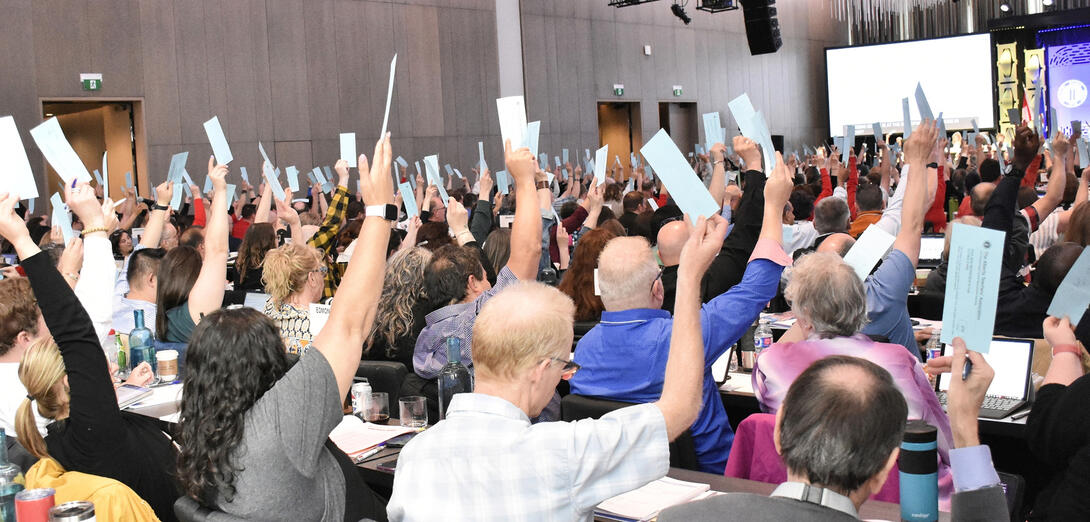Question: Why are voting rules and procedures changing?
Answer: As a democratic organization, providing members with the opportunity to vote and facilitating their participation in the process is vitally important. To encourage the greatest possible turnout and to ensure the integrity of the vote, the Association has transitioned through a variety of approaches.
Originally, voting in Provincial Executive Council elections was done by paper ballot distributed, collected and submitted by school representatives. When the opportunity to run elections online became available, the Association initiated a voting process that involved having members visit a voting webpage to cast their ballot. The challenge with this approach was ensuring that those voting were entitled to do so. To do this, members were asked to update and access their profile in the Association’s Alinity database. The actual voting system, operated by an independent third-party provider, would use the information in the database to verify voter eligibility and prevent anyone from casting multiple votes.
This “passive-pull” system worked reasonably well, but voter turnout in PEC elections and on earlier memorandum votes was rather lower than desired. Given that the process of concluding a new central table agreement would require conducting one and possibly more votes of the entire active membership, a new “active-push” approach was adopted. With email addresses having been collected by school representatives and locals and solicited on an online registration site for this limited purpose, the Association was able to send individual members a link enabling them to vote.
This approach was first used in the vote on the mediator’s recommendation, which saw 35,817 teachers turn out, more than 81 per cent of the 44,183 registered voters, and the highest participation rate in the modern history of the Association. In contrast, a similar vote in 2022 saw only 23,101active members turn out, barely half of those eligible.
Despite this success, we did have some difficulties getting ballots to a small number of members in a timely fashion. This was largely the result of factors external to the Association’s control, including delayed delivery of messages containing the ballot from the provider Big Pulse and, in some cases, individual user preferences and settings that identified these messages as junk.
Furthermore, for the strike vote, we will be changing service providers to Simply Voting. Based out of Montreal, this company has extensive experience in managing the type of vote we are conducting and has worked previously with unions in Canada and the United States. Changing providers mid-stream may present some challenges, but we believe that Simply Voting will be able to offer a more reliable voter experience.
The vote on the mediator’s recommendation could be conducted under the Association’ own rules. A formal strike vote, however, must be conducted under the strict rules set by the Labour Relations Board (LRB), which limits eligibility to active members who have provided direct service to the employer in the 60 calendar days prior to the vote taking place. This precludes participation in the vote by members who, for any reason, have been on leave for the entirety of that period and, also, of substitute teachers who have not taught in that time frame. Voters will have to complete a solemn attestation that they meet all the eligibility criteria set by the LRB before they will be permitted to complete and submit their ballot.
The LRB also is requiring us to provide alternative ways of voting to ensure that no eligible member is disenfranchised through lack of access to the necessary technology. While the vast majority will be able to vote using the same “active-push” system used previously, we will have the capacity to offer individuals who are unable to receive a ballot individual access through an alternate online portal. As a last resort, those who simply cannot vote using either of these options will be able to travel to one of seven in-person voting centres that will be established in High Level, Fort McMurray, Grand Prairie, Edmonton, Red Deer, Calgary and Lethbridge to complete a paper ballot.
Votes originating from the three processes will then be collected, counted and, following a period when employers can lodge an objection to the process, the results authorized by the LRB for release to members.
Please visit the Association website for the most current information and stay attuned to any communication coming to you directly from the Association or simplyvoting.com.
Editorial note: Since going to press, this Q&A has been updated to reflect the switch in service providers for voting. This update appears in the digital version of the ATA News only.

ATA Executive Secretary


